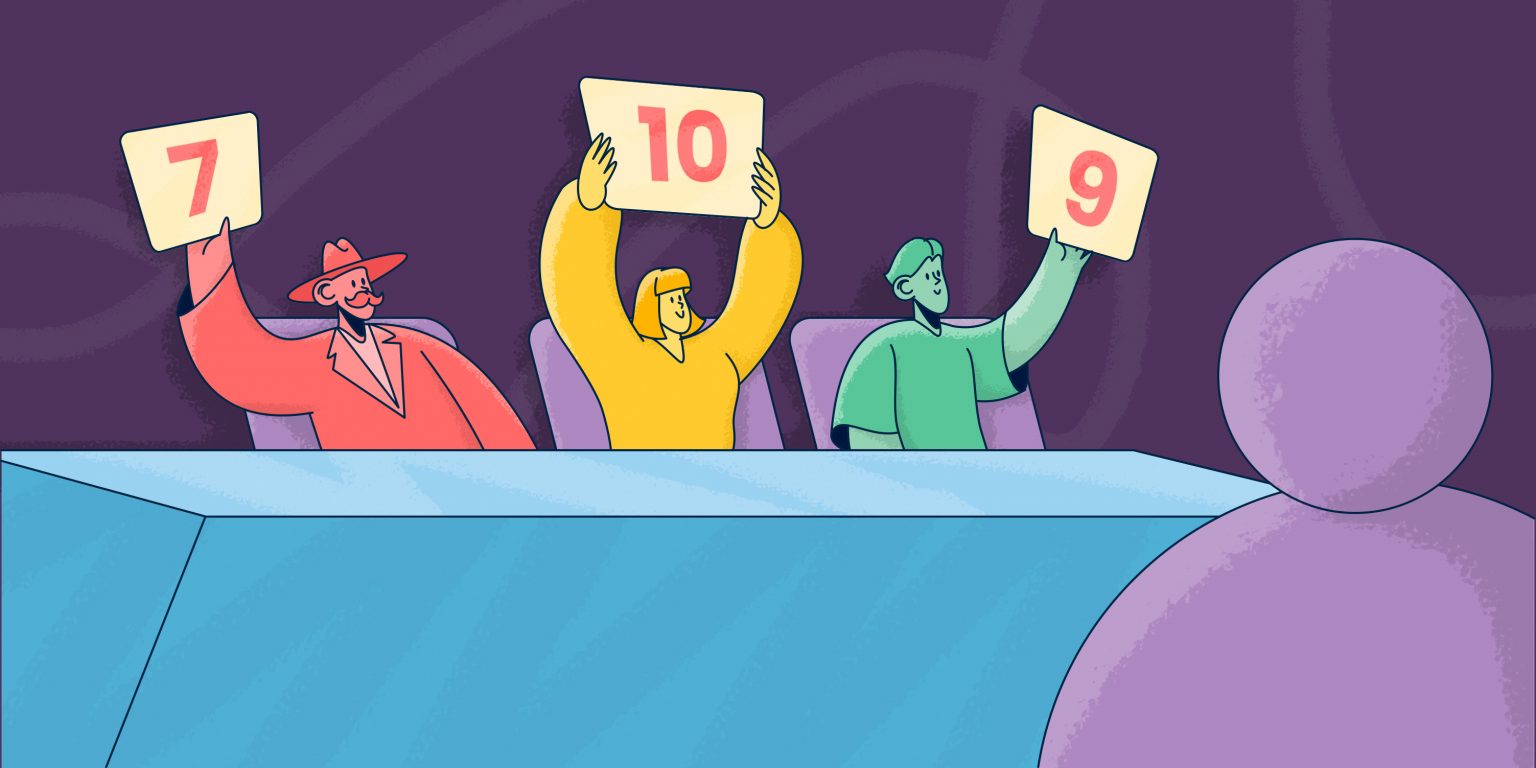In the ideal world, both inbound and outbound leads you’ve generated would be ideal fits to start sales pitching to. The truth is, however, that we don’t live in the ideal world, so from time to time, dead-end contacts or uninterested leads pop up in your list.
I don’t want to paint a black picture here, but let me warn you: wasting time on wrong leads and missing out on prospects ready for a deal can result in a revenue decrease and forthcoming customer loyalty problems.
To avoid such consequences, successful companies hurry up to adopt a clever lead qualification process, where the lead scoring mechanism plays a pivotal role.
In one of the recent Snov.io guides, I’ve already mentioned lead scoring as a lead qualification strategy. In this post, we’ll talk about it in more detail and find out how to run an effective lead scoring process step by step.
Outline:
Lead scoring: definition and parameters
So what is lead scoring?
Lead scoring is a sales and marketing system for determining the business value of each generated lead. It’s displayed as scores (hence the term) based on the predefined criteria showing how close the potential customer is to purchase and whether they require further lead nurturing.
The assessment of leads usually takes place according to two groups of parameters, both of which should be evaluated if you want to build an accurate picture of your leads:
- External (explicit) – identifiable demographic data about a lead or the information they usually tell you, for instance, their company size, location, industry, market segment, job title, and so on;
- Internal (implicit) – information that pertains to the lead’s behavior, such as their body language during a call, the number of visits to your company’s website, email opens, subscription to your newsletters, attendance of your events, and more.
IMPORTANT: Lead scoring shouldn’t boil down to selecting only “hot” leads and ignoring the rest of the database.
Lead scoring vs. lead qualification
Sometimes lead scoring is confused with lead qualification, but even though both practices aim to identify potential customers, there are points of difference between them.
The goal of lead qualification is to determine whether a lead fits your ideal customer profile (ICP) and has a chance of becoming a long-term customer. Lead qualification helps you filter a clutter of contacts that have joined your database and focus on the right leads that will be further nurtured and introduced to the sales team.
The goal of lead scoring is to assess every lead with a value point (a numeric score) based on the criteria you’ve previously determined as indicative of their readiness to buy. In other words, lead scoring is an accurate calculation-based way of lead qualification.
Why is lead scoring important?
When implemented correctly, lead scoring can bring your company many benefits. In particular, it allows you to:
Save time and improve efficiency
By using lead scoring, you can reduce the time spent on evaluating leads. You just need to indicate the main criteria for the lead quality and their weight in the final assessment.
And with a CRM or similar software, you’ll be able to automate the process, focusing on personalization-based tasks. The system will evaluate potential customers, assign points to them, and automatically assign them to the sales department. As a result, company processes become more efficient, and your overall productivity grows.
Identify the right lead channels
Lead scoring allows you to understand which marketing channels bring you more qualified leads and reduce budget expenditures.
For example, imagine you have two channels, one of which brings you 200 leads while the other brings you only 30. On the surface, it seems that the first channel performs better. But as soon as you run lead scoring, it turns out that among the 200 leads you’ve generated with the first channel, only 20 are likely to become your customers. Meanwhile, among the 30 leads you’ve gathered with the second channel, 25 appear sale-ready.
Conclusion: apparently, it’s better to run an advertising campaign on the second channel as it has a lower cost of attracting potential customers.
Align sales and marketing
When your company implements a distinct system of scoring leads, marketers will have a clear understanding of whether this or that lead is sales qualified and whether it’s the right time to pass them over to the sales team.
Therefore, lead scoring ensures a timely, well-organized lead handoff, keeps you away from any confusion that often arises when teams can’t sync their processes, and, overall, strengthens sales and marketing alignment.
Increase revenue
With lead scoring, sales reps know which leads should be given priority. Therefore, such leads will be timely followed up, given special attention, and approached in the most personalized way.
No surprise, 38% of businesses claim they’ve got higher lead-to-opportunity conversion rates thanks to lead scoring. By sales pitching qualified leads, you’ll inevitably get more closed deals…and higher revenue.
Successful lead scoring step by step
You may come across various lead scoring models offered by experts, yet there is no single one to follow. Each company chooses its own way of evaluating leads based on the most important criteria.
In B2B, even though you might find the right company as a potential customer, it doesn’t guarantee you’ll close the deal easily. You need to reach out to the right person. That is why you should focus more on a lead’s position and decision-making power in your lead scoring model.
Let’s discuss how to run a successful lead scoring step by step.
Step 1. Create an ICP
Before evaluating leads, define the criteria your ICP should meet. For example, you can specify the industry your target company should belong to, its size and level (whether it’s a startup, small business, or large enterprise), location, pain points your product or service can solve, decision-making factors, etc.
Getting these pieces of information together enables you to narrow your reach and dedicate your time and effort to attracting companies that fit the ICP best.
Here’s an example of an ICP from Snov.io:
| Ideal customer profile template | ||
| Factors | Example | Your ICP |
| Industry | B2B SaaS | |
| Location | USA, China, Canada | |
| Size | 50-10 employees | |
| Growth level | Startup | |
| Budget | $500-1500K | |
| Business objectives | -To grow their customer base 50% each coming year -To become the top web design service in 4 years |
|
| Pain points | -They don’t have a systematic approach to all business processes -Cold email outreach has a low reply rate -They have a relatively low brand awareness -Marketing and sales are not aligned |
|
| Decision-making factors | -They make decisions based on facts, testimonials, case studies -The decision-making is made by a team of top managers, not just by the CEO |
|
| Channels for outreach | LinkedIn, email | |
Read our post to learn more about creating an ICP for your company.
Step 2. Analyze your target audience
Now you need to find out what your customers have in common and what made them convert. To do this, dive deeper into your analytics, namely:
- Review past deals to get information about the activities and campaigns that pushed the prospect to purchase.
- Ask your current customers what made them make the final purchase decision.
- Look at your lead’s online activity and find out what they are doing on your website before becoming customers.
- Ask your sales team about what interests your target audience most of all.
- Test leads that have been already qualified for sales on how their demographics and behavior correspond to your ICP.
Here is what the results of your analysis may look like:
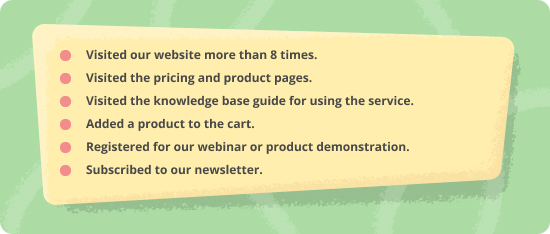
The list can be as long as you need. Your goal should be getting a clear picture of your target audience and understanding how they mirror your ICP.
Step 3. Determine the scoring criteria
At this stage, you should determine the main criteria (characteristics) for scoring to rank all your leads objectively.
Remember two groups of lead scoring parameters? That’s where they become your criteria to differentiate:
- External (demographic). List all the demographic criteria for assessing your leads based on the ICP you created earlier. For example, your lead scoring template may look like this:
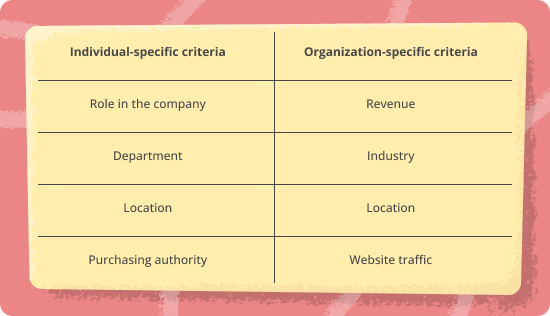
- Internal (behavioral). List all the lead activities you need to assess how they fit the ICP. Consider the following template you can steal for scoring the behavioral criteria of your leads:
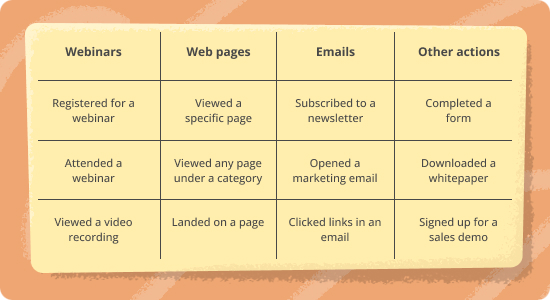
Step 4. Assign point values
As soon as you’ve identified categories for scoring, you should think about how many points each of the criteria costs. Not all the criteria will be equally important – you should give more points to those that better contribute to deal closing.
For instance, if, while analyzing your target audience, you’ve found out that leads who visit your webinars convert into paying customers more often, unlike those who open marketing emails, you should naturally give more points to ‘visited a webinar’ than ‘opened a marketing email.’
Marketo suggests splitting all criteria into four groups: critical, important, influencing, and negative.
Take a look at a lead scoring model example from Marketo with the points assigned based on the importance of lead scoring criteria:

As you see, negative points are given for the unwanted behavior of leads. It’s a good idea to include them in your lead scoring model to better filter those leads who don’t fit the image of an ideal customer.
REMEMBER: Marketers and sales reps should agree on the importance of lead scoring factors and the numeric value of each criterion. If sales and marketing are at odds in this matter, you can miss out on many promising leads.
Lead scoring template
You can apply the following lead scoring template, which includes both demographic and behavioral criteria. Feel free to change the criteria and the number of points based on their importance.
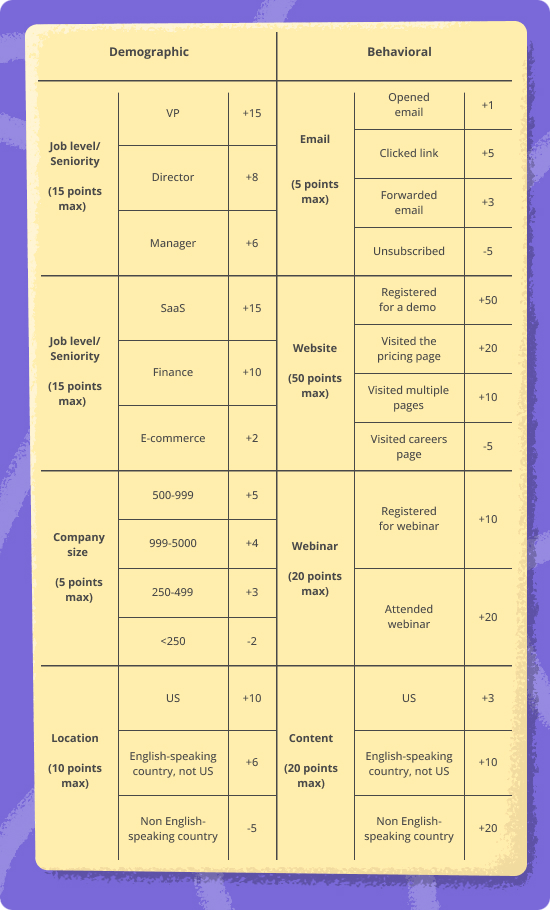
Step 6. Determine a threshold point value
After completing the previous steps, you need to count the total and define the score range that means a lead is qualified for sales. I recommend using a scale of priority. For instance:
- 30-45 points – high priority;
- 15-29 points – average priority;
- Less than 15 points – low priority.
Let’s imagine we’ve got a lead that we want to score based on the demographic factors stated in the template above:
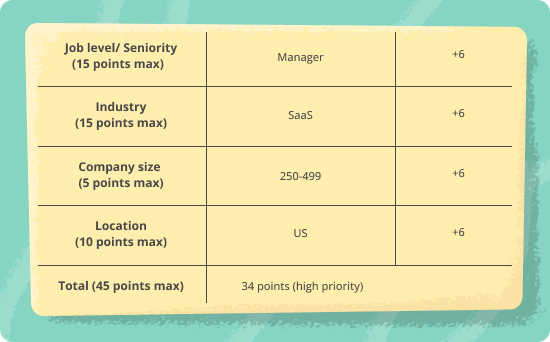
Our imaginary lead has got 34 points, which indicates they are sales qualified and should be reached out right away.
#7. Automate processes
I already expect the question: “Do I need to score each lead manually based on all these criteria? Are you crazy?”
Well…although I have nothing against the popular Google Sheets, I need to admit that scoring leads manually is indeed a job you’ll hardly cope with…unless you’ve got automation tools that will simplify the process.
For instance, with ActiveCampaign, you can set the lead scoring rules that make sense for your business and score leads based on their personal and behavioral data.
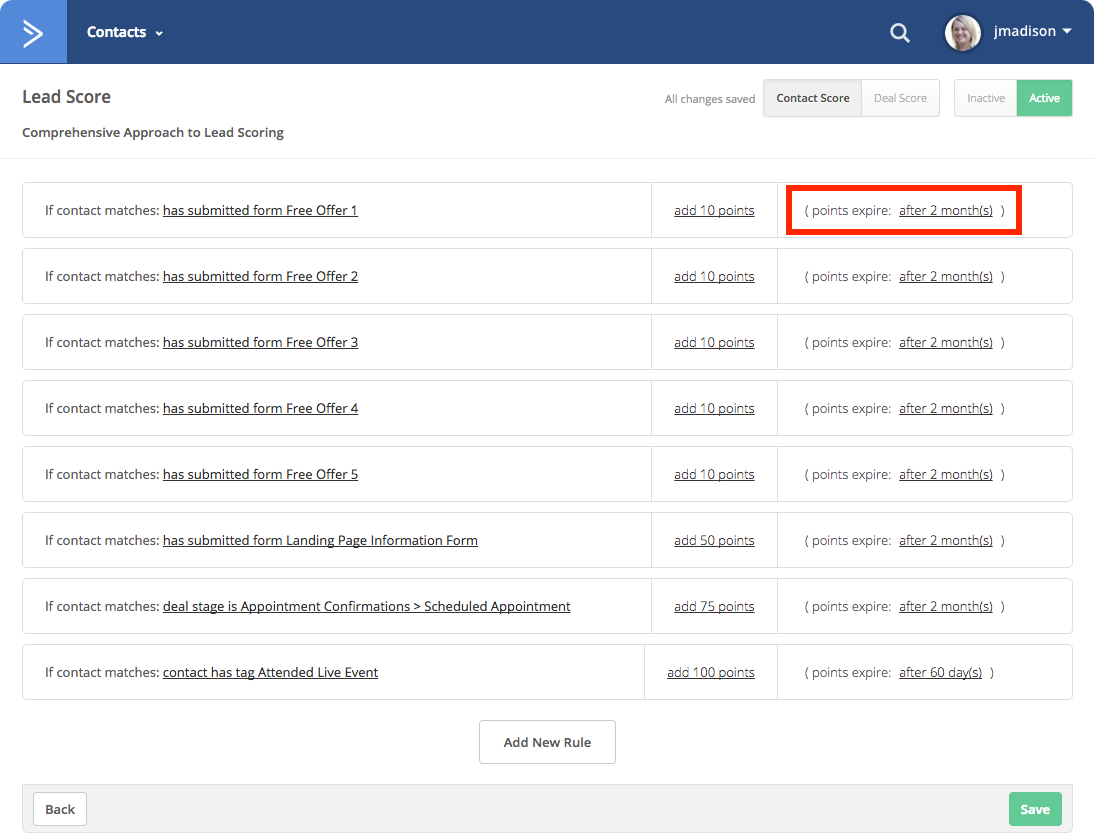
HubSpot lead scoring offers two models: manual and predictive. While predictive lead scoring will show you the likelihood of a lead to close, manual lead scoring allows you to set your own criteria. As soon as you carefully select attributes for the criteria, the tool will assign numerical scores depending on their importance.
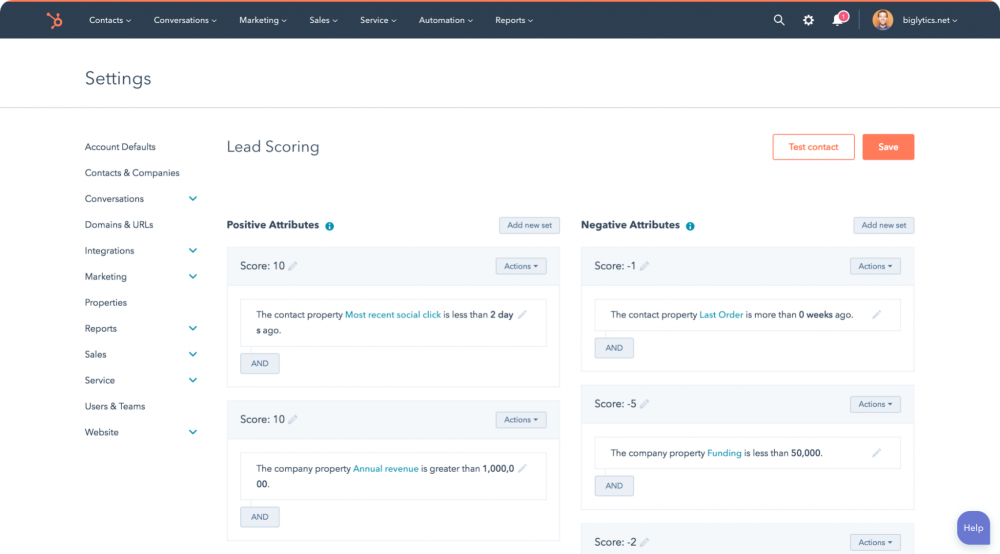
And right after scoring, you can use Snov.io free CRM to organize your lead base and focus on reaching out to those leads who are most ready to buy your product.
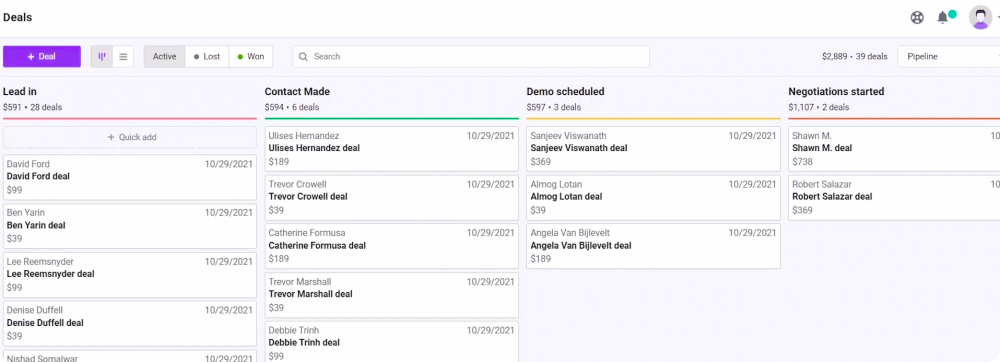
With Snov.io Email Drip Campaigns, you can follow up with your sales-qualified leads as soon as they’ve shown the top score and nurture average-priority leads.
5 tips on how to run lead scoring more effectively
In the final chapter, I’ve tried to accumulate recommendations on how to do lead scoring most efficiently. Consider these five tips next time while practicing lead scoring in your company.
- Evaluate both demographics and behavior. Buyer behavior analysis is one of the crucial factors of successful deals, so don’t neglect behavioral parameters while doing lead scoring.
- Don’t score on a whim. Assign points to each category thoroughly based on the principles of your company previously, discussing them with the teams in charge (both marketing and sales).
- Ask for customer feedback regularly. Your current customers know better what has motivated them to purchase your product and stay with your company for long, so they can be your primary source of information while choosing the right criteria for lead scoring. Send your customers regular surveys to better understand their buyer personas.
- Track MQL (marketing qualified leads) conversion rates. This metric allows you to determine how many MQLs turn into SQLs (sales-qualified leads) or opportunities.
- Reconsider your lead scoring model from time to time. Gather sales and marketing teams together (at least once a quarter) to discuss whether the existing lead scoring model works fine and how to adjust the scores so that the process brings better results.
Wrapping up
Lead scoring is one of the best ways to qualify a lead and ensure both marketing and sales teams have the same vision on their readiness to buy. To make your lead scoring system uniform and effective, you need to establish regular cooperation between these departments and come to an agreement on lead scoring categories and their weight.
As doing lead scoring manually may be rather challenging, rely on specific tools that will help you simplify the process and save you precious time. And if you still hesitate about what platform to use to keep track of all your leads and reach out to the sales-ready prospects instantly, Snov.io free CRM welcomes you on board!
